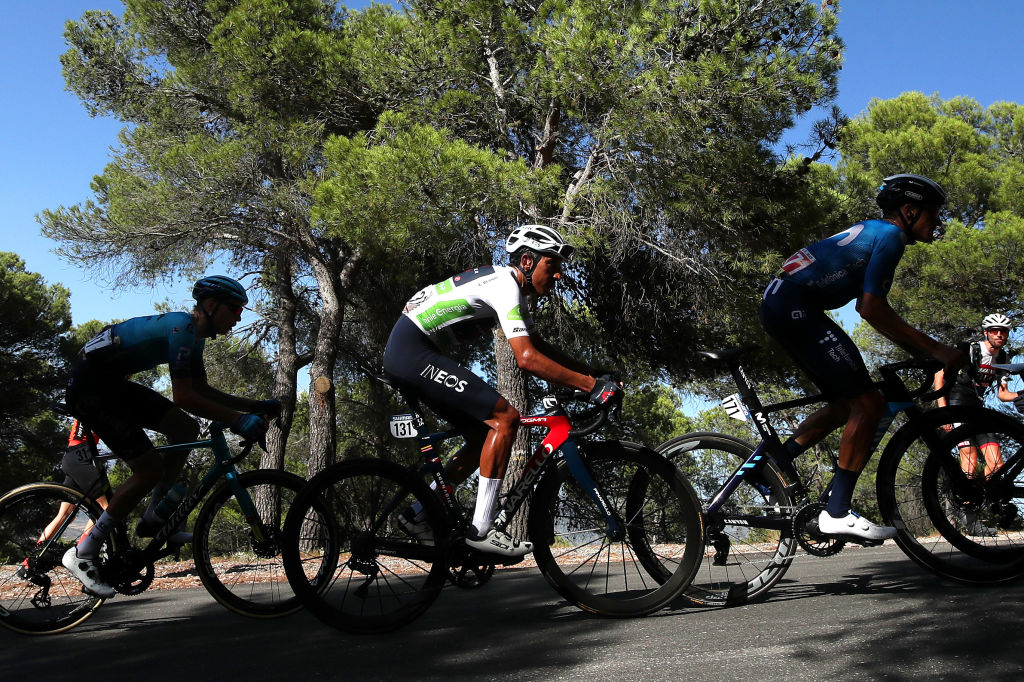Egan Bernal: It's good for Ineos to have cards to play at Vuelta a España
Colombian admits he's not at 100 per cent as he finishes alongside Roglič on Balcón de Alicante

Different races, different situations, different approaches. At this point at the Giro d'Italia, Egan Bernal was already laying down an early marker and putting time into his overall rivals.
A week into the Vuelta a España, the Colombian's primary focus seems to be on keeping Primož Roglič (Jumbo-Visma) within his sights before the race's arduous final stretch.
If Bernal's fast start in Italy in May seemed to come as a surprise even to himself, his more measured opening stanza to this Vuelta is perhaps in keeping with his build-up to the race.
The Ineos Grenadiers leader was diagnosed with COVID-19 in the week after winning the Giro and his only competition since came at the Clásica San Sebastián and the Vuelta a Burgos.
Throughout this Vuelta, Bernal has repeatedly insisted that he is not yet at 100 per cent, but he still had the strength to finish alongside Roglič on Balcón de Alicante on stage 7 after his Ineos teammate Adam Yates had whittled the red jersey group down to just to just seven riders on the steepest portion of the climb.
In the overall standings, Bernal lies in 6th place, still 41 seconds down on Roglič, and he continues to wear the white jersey of best young rider.
"I think it was a hard stage," Bernal told reporters when he paused in the mixed zone after the stage. "The parcours was really hard, it was all day up and down. I think the heat was really high, but I think finally we did well. We didn't lose time on GC against the favourites, so it was a good day for us."
Get The Leadout Newsletter
The latest race content, interviews, features, reviews and expert buying guides, direct to your inbox!
Carapaz and Yates
Balcón de Alicante, which featured in the Vuelta for the first time, was the most demanding ascent on the stage, though the most dramatic moments came on the day's earlier climbs, where, at one point, the day's break was larger than the red jersey group behind.
Bernal had his teammate Pavel Sivakov on policing duty in the escape, and the Russian eventually rode to third on the day behind winner Michael Storer (DSM).
"It was a massive group going, and we thought if a big group is going, then we need someone in there," Sivakov explained, a thought echoed by Bernal.
"If there are thirty riders in the front, it's always nice to have one of you there," the Colombian said. Jumbo-Visma clearly felt the same way, given that Sepp Kuss was also aboard the move.
When Movistar launched an offensive on the Puerto El Callao, meanwhile, Richard Carapaz entered the fray for Ineos. The Ecuadorian pressed on first in the company of Alejandro Valverde and, after the Spaniard crashed out of the race, he joined a short-lived effort with Miguel Angel López and Roglič himself.
"I think it was all because Movistar went first, that's why he went," Bernal said of Carapaz's cameo. "In the middle of the stage, it was riding to follow the others."
On the final ascent, meanwhile, it was another member of the Ineos triumvirate, Adam Yates, who took up the reins, setting in motion a winnowing process in the red jersey group. Carapaz was among those distanced, losing half a minute in the company of Mikel Landa (Bahrain Victorious) and Giulio Ciccone (Trek-Segafredo).
"The final climb was really fast at the beginning, and the last two kilometres were steep. It was a kind of punchy climb, so I preferred to stay with the favourites," said Bernal.
Ineos began this Vuelta with a troika of leaders and with directeur sportif Matteo Tosatto insisting that the road would eventually decide the internal hierarchy.
A week into the race, Bernal, the man with the best Grand Tour pedigree, is also the best placed on general classification, though he insisted that Yates (10th at 1:22) and Carapaz (16th at 2:48) remain live threats in the overall standings.
"I think it can be an option, you know," he said. "La Vuelta is really hard and you can see today it was a big breakaway, so if we have Carapaz or Yates – who are really, really good riders – up there in the GC within around 2-3 minutes, then they are still dangerous in GC.
"I think it's not a bad idea to have them up there in the GC. I'm also not at my 100 per cent, so even for me it's better if we have some cards to play."

Barry Ryan was Head of Features at Cyclingnews. He has covered professional cycling since 2010, reporting from the Tour de France, Giro d’Italia and events from Argentina to Japan. His writing has appeared in The Independent, Procycling and Cycling Plus. He is the author of The Ascent: Sean Kelly, Stephen Roche and the Rise of Irish Cycling’s Golden Generation, published by Gill Books.